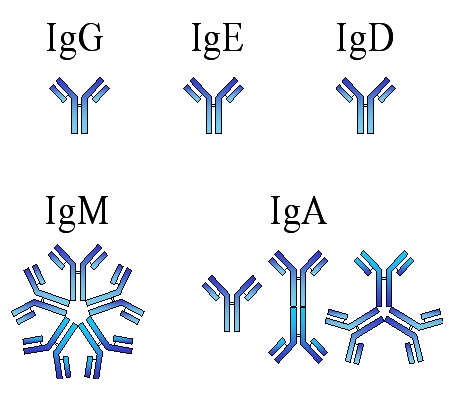Immunoglobulin - what is and definition

Immunoglobulin is a protein structure the IMMUNE SYSTEM produces. Immunoglobulins are the foundation molecules for the formation of antibodies. Immunoglobulins circulate in the BLOOD. The immunoglobulin’s class designation reflects its molecular structure, which in turn dictates the action of the immunoglobulin. The five major classes of immunoglobulin provide different kinds of antibodies:
- Immunoglobulin A (IgA) is the main immunoglobulin in the body’s secretions (tears, saliva, and mucus) and in colostrum, the first discharge from the mother’s breasts after childbirth. It is the second most abundant immunoglobulin in the blood circulation. IgA boosts the IMMUNE RESPONSE capacity of the various MUCOSA-ASSOCIATED LYMPHOID TISSUE (MALT) structures. IgA blood levels decrease in lymphoblastic leukemias and increase in certain AUTOIMMUNE DISORDERS, notably RHEUMATOID ARTHRITIS and SYSTEMIC LUPUS ERYTHEMATOSUS (SLE).
- Immunoglobulin D (IgD) resides on the surface of the cell membrane of B-cell lymphocytes. Its primary role is to bind with antigens. IgD blood levels increase with chronic infections and certain myelomas.
- Immunoglobulin E (IgE) produces the antibodies responsible for HYPERSENSITIVITY REACTION as well as primary INFECTION-fighting antibodies. It also is the immune response’s main defense against parasitic infection. IgE is the least abundant of the immunoglobulins in the blood circulation. Blood levels of IgE rise with hypersensitivity reactions.
- Immunoglobulin G (IgG) is the most abundant and versatile of the immunoglobulins. It makes up 75 percent of the immunoglobulin in the blood circulation. IgG binds with many types of leukocytes and activates the COMPLEMENT CASCADE. IgG is the only immunoglobulin that can cross the placental barrier between mother and fetus. IgG blood levels increase with infection and rheumatoid arthritis and decreases with lymphoblastic LEUKEMIA.
- Immunoglobulin M (IgM) is the third most abundant class of immunoglobulin in the blood circulation. The first contact with an ANTIGEN causes a B-CELL LYMPHOCYTE to produce IgM. IgM antibodies help collect cellular debris for more efficient PHAGOCYTOSIS. Blood levels of IgM increase with infectious mononucleosis, MALARIA, SLE, and rheumatoid arthritis.
Immunoglobulins collected from donated blood and PLASMA are blended to produce GAMMAGLOBULIN, a therapeutic form that boosts the nonspecific immune response.
For further discussion of immunoglobulins within the context of the structures and functions of the immune system, please see the overview section “The Immune System and Allergies.”
See also ANTIBODY; ANTIBODY-MEDIATED IMMUNITY; LEUKOCYTE; LYMPHOCYTE; MONONUCLEOSIS, INFECTIOUS; VACCINE.
Open discussion on the topic Immunoglobulin - what is and definition
Similar interests
- Casino Non Aams
- Nuovi Casino
- Casinos Not On Gamstop
- UK Casinos Not On Gamstop
- Casinos Not On Gamstop
- UK Casinos Not On Gamstop
- Casino Non Aams Italia
- Slot Sites Not On Gamstop
- Meilleur Casino En Ligne
- Non Gamstop Casino Sites UK
- Meilleur Casino En Ligne
- Casino En Ligne France
- Best Non Gamstop Casinos
- Casinos Not On Gamstop
- UK Casino Not On Gamstop
- Casinos Not Signed Up To Gamstop
- Best Slot Sites UK
- Non Gamstop Casino Sites UK
- Online Casinos Nederland
- Online Casinos Nederland
- Casinos Not On Gamstop
- Best New Uk Casinos Not On Gamstop
- Casino Non Aams
- Non Gamstop Casinos UK
- Migliori Siti Casino Non Aams
- Bitcoin Casinos
- Sites De Paris Sportifs Belgique
- Bookmaker Non Aams
- Casino En Ligne
- Casino Français Sans Kyc
- Casino Nouveau En Ligne